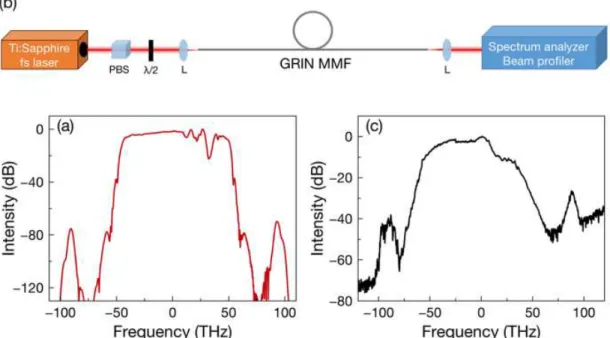JTu3A.72.pdf Frontiers in Optics 2017 © OSA 2017
Geometric parametric instability of femtosecond
pulses in graded-index multimode fiber
U˘gur Te˘gin and B ¨ulend Ortac¸
National Nanotechnology Research Center (UNAM) and Institute of Materials Science and Nanotechnology, Bilkent University, 06800 Bilkent, Ankara, Turkey
ugur.tegin@bilkent.edu.tr
Abstract: We numerically and experimentally study the spatio-temporal femtosecond pulse evolution in graded-index multimode fiber at normal dispersion regime. We report the first demonstration of geometric parametric instability sidebands generation with ultrashort pulses in the literature.
OCIS codes: 060.4370, 190.0190
Novel nonlinear dynamics due to spatio-temporal pulse propagation inside graded-index multimode fiber (GRIN MMF) have attracted huge attention in the recent years. Among these phenomena, geometric parametric instability (GPI) offers unrepresented frequency shift with remarkable spatial beam shape. GPI is associated with periodic re-focusing inside GRIN MMFs and theoretically predicted by Longhi [1]. Later, the proposed theory is verified by experimental studies and GPI sidebands are reported with more than 100 THz detuning from to pump frequency [2, 3]. These studies focused on quasi- continues pulse evolution in GRIN MMF because of the analogy between GPI and the modulation instability thus the spatio-temporal evolution of femtosecond pulses at normal dispersion regime remains unknown. Here, we present the first experimental observation of GPI sidebands with femtosecond pulses in GRIN MMF. To gain detailed understanding, we perform numerical simulations and theoretical calculations and obtained results are well-aligned with experimental observations.
We perform numerical simulations by coupled-mode analysis method [4]. We launched We launch pulses with 200 fs pulse duration, 350 nJ pulse energy at 800 nm. Even though GRIN MMF supports hundreds of modes at 800 nm, to reduce computation time, we perform a simulation with linearly polarized first six cylindrically symmetric modes for 30 cm GRIN MMF with 50µm core diameter. The initials pulse energy is distributed among these six modes (50% in p=0, 18% in p=1, 13% in p=2, 10% in p=3, 6% in p=4 and 3% in p=5) and obtained results are presenting first GPI sidebands with 90 THz frequency offset from the central pump frequency (see Fig.1(a)). The pulse propagation equation used in the numerical calculations for the each fiber mode p is presented as:
∂Ap ∂z = iδ β (p) 0 Ap−δ β (p) 1 ∂Ap ∂t − i β2(p) 2 ∂2A p ∂2t + iγ 3(1 + i ω0 ∂ ∂t)l,m,n
∑
ηplmn[(1 − fR)AlAmA ∗ n+ fRAl Z hRAm(z,t −τ)A∗n(z,t −τ)dτ]whereηplmnis nonlinear coupling coefficient, fR≈ 0.18 is the fractional contribution of the Raman effect,hRis the
delayed Raman response function andδ β0(p)(δ β1(p)) is difference between first (second) Taylor expansion coefficient of propagation constant for corresponding and the fundamental mode.
In experiments, we use an amplified Ti:Sapphire laser as a pump source to generate linearly polarized, single- mode, 200 femtosecond ultrashort pulses at 800 nm with 1 kHz repetition rate. A GRIN MMF with 50 m core diameter is excited with a lens and three-axis translation stage configuration (Fig.1(b)). When we excite sufficient amount of high order modes with 354 nJ pump pulse, we obtain first GPI peak pair with 91 THz frequency shift (Fig.1.(c)). First Stokes and anti-Stokes peaks are observed around 1055 nm and 645 nm with 12 nm and 5 nm spectral bandwidths, respectively. Commonly used theoretical calculation [1,2,3] suggests that 89 THz frequency detuning is expected for first GPI peak pair when pump pulses are selected at 800 nm which corresponds to 1049 nm and 646 nm for first GPI Stokes and anti-Stokes, respectively. Experimentally obtained spatial intensity distribution of first GPI Stokes features Gaussian shape as the pump pulse.
JTu3A.72.pdf Frontiers in Optics 2017 © OSA 2017
Fig. 1. (a) Numerically obtained spectrum with 345 nJ, 200 fs pulses after 30 cm GRIN MMF. (b) Schematic of the experimental setup. (c) Experimentally obtained spectrum with 345 nJ, 200 fs pulses after 260 cm GRIN MMF.
In conclusion, we study the spatio-temporal evolution of femtosecond pulses in GRIN MMF experimentally and numerically. Our results present the first demonstration of GPI sidebands generation with ultrashort pulses in the liter-ature. Numerical simulations and theoretical calculations validate experimental observations. Observed results provide inside of the GPI formation with ultrashort pulses to complete spatio-temporal pulse evolution studies and indicate that the known attractor effect observed in GRIN MMF for quasi-continuous pump pulses also exists for ultrashort pump pulses [5]. With unique frequency shift, GPI can be used as new wavelength generation method. Obtained frequency shifts are depending on the wavelength of the pump pulses thus it can be tuned for desired applications.
References
1. S. Longhi, “Modulational instability and space time dynamics in non- linear parabolic-index optical fibers,” Opt. Lett. 28, 2363-2365 (2003).
2. K. Krupa, A. Tonello, A. Barthelemy, V. Couderc, B. M. Shalaby, A. Bendahmane, G. Millot, and S. Wab-nitz, Observation of geometric parametric instability induced by the periodic spatial self-imaging of multimode waves, Phys. Rev. Lett., 116, 183901–183906 (2016).
3. S. Longhi, “Modulational instability and space time dynamics in non- linear parabolic-index optical fibers,” Opt. Lett. 28, 2363-2365 (2003).
4. G. Lopez-Galmiche, Z. S. Eznaveh, M. Eftekhar, J. A. Lopez, L. Wright, F. Wise, D. Christodoulides, and R. A. Correa, Visible supercontinuum generation in a graded index multimode fiber pumped at 1064 nm, Opt. Lett. 41, 2553-2556 (2016).
5. L. G. Wright, Z. Liu, D. A. Nolan, M.-J. Li, D. N. Christodoulides, and F. W. Wise, Self-organized instability in graded-index multimode fibres, Nat. Photon. 10, 771-775 (2016).
